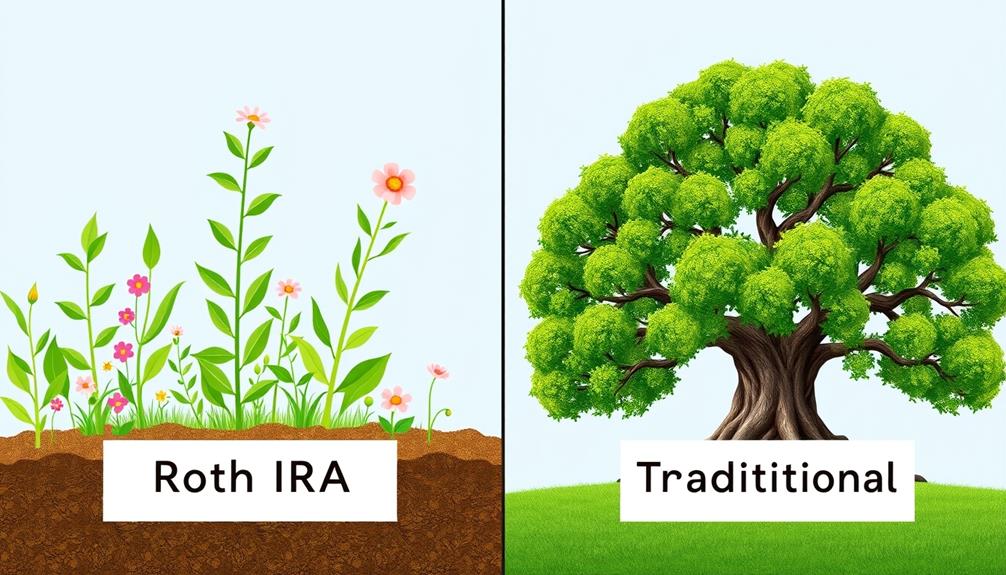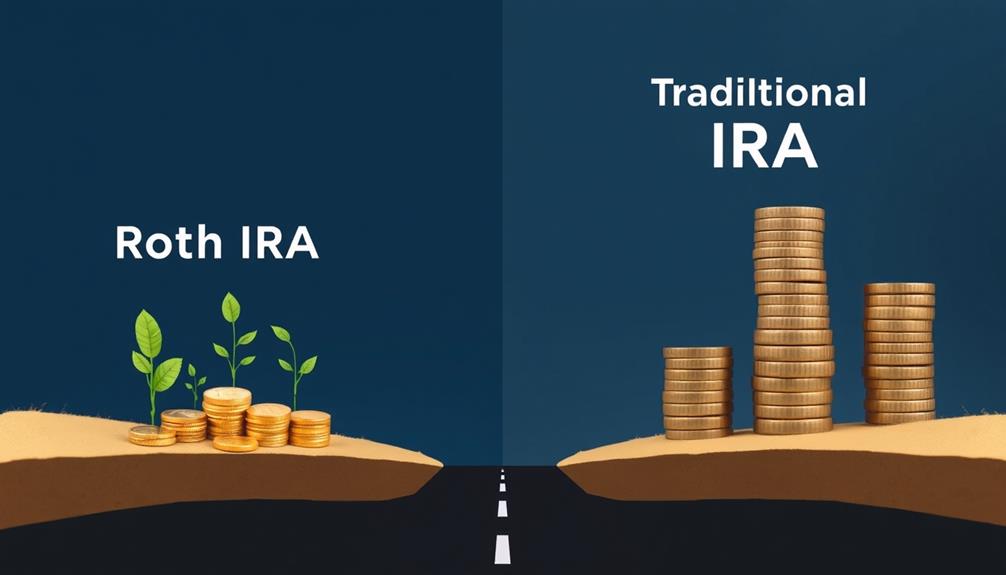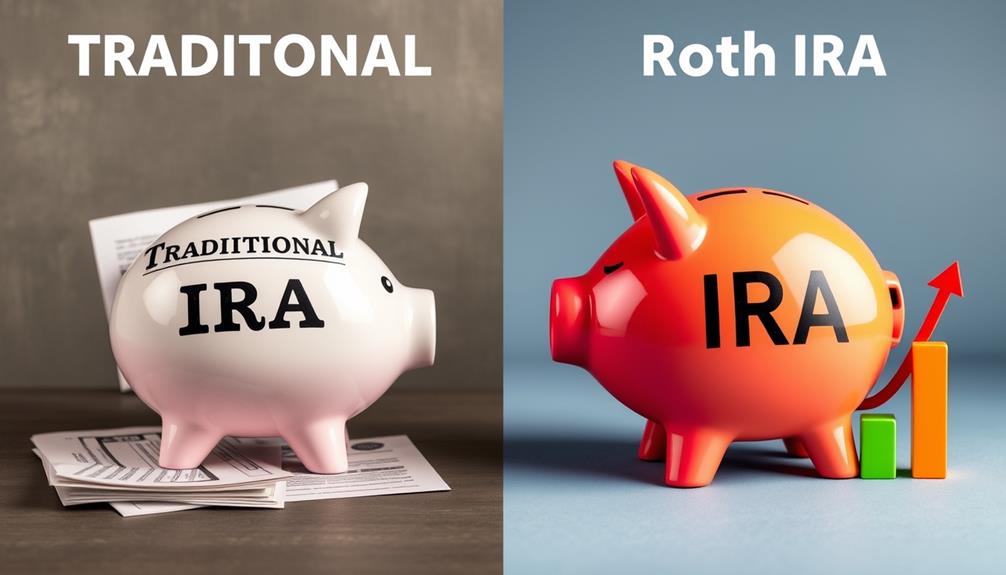Deciding between a **Roth IRA** and a **Traditional IRA** depends on your financial goals and situation. If you aim for **tax-free withdrawals** during retirement and anticipate being in a higher tax bracket later on, a Roth IRA could be the way to go. Conversely, if you seek **immediate tax deductions** and favor tax-deferred growth, the Traditional IRA may suit you better. Your age, income, and withdrawal flexibility are crucial considerations. Both choices offer distinct benefits that influence your retirement plan and financial outlook. Dive deeper to discover additional insights that can assist you in making the best choice for your future.
Key Takeaways
- Consider a Roth IRA if you expect to be in a higher tax bracket during retirement for tax-free withdrawals.
- Choose a Traditional IRA for immediate tax deductions, lowering your taxable income in the contribution year.
- Evaluate your age; you can contribute to a Roth IRA at any age, while Traditional IRA contributions stop after age 70½.
- Assess your need for withdrawal flexibility; Roth IRAs allow penalty-free access to contributions anytime.
- Factor in RMDs; Traditional IRAs require withdrawals starting at age 73, while Roth IRAs have no such requirement, allowing for indefinite growth.
Overview of Roth and Traditional IRAs

When it comes to retirement savings, understanding the differences between Roth and Traditional IRAs is essential for effective financial planning. A Roth IRA allows you to make contributions with after-tax dollars, meaning your withdrawals during retirement are tax-free. This feature makes it an attractive option for those seeking tax benefits in retirement.
On the other hand, a Traditional IRA permits pre-tax contributions, which can lower your taxable income now, but you'll face ordinary income tax on withdrawals in retirement. It's important to evaluate your investment goals when deciding which IRA aligns with your future plans.
In 2024, you can contribute up to $7,000 to both Roth and Traditional IRAs, or $8,000 if you're aged 50 or older. An important distinction is that Roth IRAs don't have Required Minimum Distributions (RMDs), letting your funds grow indefinitely.
In contrast, Traditional IRAs require RMDs to start at age 73, affecting your retirement strategy. When assessing income limits, Roth IRA contributions phase out for single filers with a Modified Adjusted Gross Income over $161,000, while Traditional IRAs have no such limits.
Additionally, Roth contributions can be withdrawn anytime without penalties, unlike early withdrawals from a Traditional IRA, which typically incur a 10% penalty. Understanding these factors helps you navigate your retirement accounts effectively.
Key Differences in Tax Treatment

When choosing between a Roth and a Traditional IRA, the timing of your tax deductions plays an essential role.
With a Traditional IRA, you get an immediate tax benefit by contributing pre-tax dollars, while Roth IRA contributions come from your after-tax income.
This distinction can affect your overall retirement strategy, especially regarding potential future tax implications and diversification of retirement portfolio.
Understanding how withdrawals are taxed later can also impact your retirement strategy considerably.
Tax Deduction Timing
Understanding the tax deduction timing is essential when choosing between a Traditional IRA and a Roth IRA. With a Traditional IRA, your contributions offer a tax deduction that lowers your taxable income in the year you contribute. This means you can enjoy immediate tax benefits, which can be particularly advantageous if you're in a higher tax bracket now.
Additionally, keep in mind the importance of consulting with a financial advisor to navigate potential risks, such as those associated with protecting your savings from scams. However, remember that withdrawals from a Traditional IRA are taxed as ordinary income during retirement.
On the other hand, contributions to a Roth IRA are made with after-tax dollars, so you won't get any immediate tax deduction. The upside? Qualified withdrawals from a Roth IRA are completely tax-free, allowing your investments to grow without future tax implications.
Another key difference is the requirement for Required Minimum Distributions (RMDs) with Traditional IRAs, which kick in at age 73. These mandatory withdrawals can lead to unexpected tax liabilities, complicating your retirement planning.
In contrast, Roth IRAs don't have RMDs, giving you more control over your withdrawals and tax timing in retirement. Ultimately, understanding these differences can help you align your IRA choice with your financial goals.
Withdrawal Tax Implications
Choosing between a Traditional IRA and a Roth IRA also involves understanding how withdrawals will impact your tax situation. With a Traditional IRA, withdrawals are taxed as ordinary income, which could lead to higher tax liabilities during retirement based on your income level.
Plus, if you withdraw contributions early—before age 59½—you may face a 10% early withdrawal penalty in addition to regular income tax. Additionally, some investors may consider diversifying their retirement portfolio with precious metal investments, which can offer unique benefits and tax implications as highlighted in Noble Gold Review.
In contrast, Roth IRA withdrawals can be tax-free if you meet specific conditions, including the age requirement of 59½ and a five-year holding period for your Roth IRA earnings. You can withdraw contributions anytime without penalties or taxes, giving you more financial flexibility.
Another key difference is the Required Minimum Distributions (RMDs). Traditional IRAs require you to start taking RMDs at age 73, impacting your tax implications and potentially pushing you into a higher tax bracket.
Roth IRAs, however, don't have RMDs during your lifetime, allowing for continued tax-free growth. Ultimately, understanding these withdrawal tax implications can help you make the best choice for your financial goals.
Contribution Limits and Eligibility

Maneuvering the contribution limits and eligibility criteria for Roth and Traditional IRAs can greatly impact your retirement savings strategy. For 2024, both Roth and Traditional IRA contributions are capped at $7,000, with an additional catch-up contribution of $1,000 for those aged 50 and older, totaling $8,000.
Here's a quick comparison of key factors:
| Factor | Roth IRA | Traditional IRA |
|---|---|---|
| Contribution Limits | $7,000 ($8,000 if 50+) | $7,000 ($8,000 if 50+) |
| Income Limits | MAGI above $161,000 (single) | No income limits for contributions |
| Age Limit | No age limit for contributions | Contributions cease after 70½ |
Roth IRA contributions are subject to income limits, while Traditional IRA contributions may face deductibility restrictions if you or your spouse are part of an employer-sponsored retirement plan and exceed certain income thresholds. You can contribute to both types in one year, but your total contributions can't surpass the annual limit. Understanding these criteria is essential to optimizing your retirement savings.
Withdrawals and Penalties

When considering withdrawals from your retirement accounts, it's crucial to know the differences between Roth and Traditional IRAs.
With a Roth IRA, you can withdraw your contributions at any time, tax-free and penalty-free. Additionally, investing in a Gold IRA can provide a hedge against inflation and offer potential long-term capital appreciation, making it a valuable option alongside traditional retirement accounts Gold IRAs benefits. However, if you want to take out earnings, you need to meet the five-year rule and be at least 59½ years old to avoid taxes and penalties.
On the other hand, early withdrawals from a Traditional IRA before age 59½ generally incur a 10% penalty on top of ordinary income taxes, although certain exceptions exist, like for first-time home purchases or education expenses.
Additionally, Traditional IRAs require you to start taking required minimum distributions (RMDs) at age 73, which can impact your cash flow and tax situation.
In contrast, Roth IRAs don't have RMDs during your lifetime, giving you more control over your withdrawals in retirement.
Understanding these nuances can help you make informed decisions about which account aligns best with your financial goals and withdrawal needs.
Advantages of Roth IRAs

The appeal of Roth IRAs lies in their unique blend of flexibility and tax advantages, making them a compelling choice for many investors. One of the standout features is the ability to make tax-free withdrawals of your contributions at any time without incurring penalties, providing greater liquidity than traditional IRAs.
Additionally, once you reach age 59½ and have held the account for at least five years, you can enjoy tax-free withdrawals of your earnings, which greatly enhances your investment growth potential. This aspect is particularly attractive for individuals looking to diversify their retirement savings through vehicles like gold investment strategies that can protect against market volatility and inflation risks.
Another major advantage is that Roth IRAs don't require Required Minimum Distributions (RMDs) during your lifetime, allowing your investments to continue growing uninterrupted. Because contributions are made with after-tax dollars, this can be particularly beneficial if you expect to be in a higher tax bracket during retirement.
Roth IRAs also offer valuable estate planning benefits. When you pass on an inherited Roth IRA, your beneficiaries can withdraw funds tax-free, minimizing their tax burdens and preserving more wealth for future generations.
These features make Roth IRAs an excellent option for those seeking both flexibility and long-term financial security.
Traditional IRA Benefits

Taking advantage of a Traditional IRA can greatly enhance your retirement savings strategy. This type of account offers several key benefits that align with your financial goals:
1. Tax-Deductible Contributions: Your contributions may be tax-deductible, which can considerably reduce your taxable income for the year. This is especially beneficial for high earners.
In addition, the diversification of retirement portfolio through assets like precious metals can complement your Traditional IRA.
2. Tax-Deferred Growth: With a Traditional IRA, your investments can grow without being taxed until you withdraw funds in retirement. This tax-deferred growth can accelerate your savings over time.
3. Lower Tax Bracket Advantage: By planning your withdrawals strategically, you might be able to take advantage of being in a lower tax bracket during retirement. This can lead to paying less in taxes on your distributions.
Keep in mind that Required Minimum Distributions (RMDs) start at age 73, ensuring that you'll eventually withdraw funds and pay taxes.
The absence of income limits also makes Traditional IRAs accessible to more individuals, including those who may not qualify for Roth contributions.
Choosing the Right IRA

When picking the right IRA, you need to weigh the tax implications and contribution flexibility of each option.
Many individuals also consider their overall financial strategy and potential income sources when making this decision, as highlighted in best websites to earn money online.
If you expect to be in a higher tax bracket during retirement, a Roth IRA might serve you better.
Conversely, if you want immediate tax benefits, a Traditional IRA could be the way to go.
Tax Implications Overview
Steering through the tax implications of Roth and Traditional IRAs can considerably impact your retirement savings strategy. Understanding how each affects your contributions and withdrawals is essential to aligning with your financial goals.
Additionally, considering other investment opportunities such as free crypto opportunities could enhance your overall portfolio diversification.
- Contributions: Traditional IRA contributions may be tax-deductible, lowering your taxable income for the year. In contrast, Roth IRA contributions are made with after-tax dollars, meaning you won't receive a current tax deduction.
- Withdrawals: Withdrawals from a Traditional IRA are taxed as ordinary income, while qualified distributions from a Roth IRA, including earnings, are tax-free after age 59½, provided the account has been open for at least five years.
- Required Minimum Distributions (RMDs): Starting at age 73, Traditional IRAs require RMDs, which can affect your future tax liabilities.
Conversely, Roth IRAs have no RMDs, allowing you more control over your retirement funds.
Contribution Flexibility Comparisons
Choosing the right IRA can greatly impact your financial flexibility in retirement. If you value the ability to access your contributions without penalties, a Roth IRA offers significant advantages. You can withdraw your contributions at any time tax-free and penalty-free, providing you with greater liquidity. This is especially beneficial in light of current trends in private equity markets, where investors are increasingly seeking transparency in private equity.
However, keep in mind that earnings have restrictions, requiring a five-year holding period and that you be over age 59½ for tax-free withdrawals.
On the other hand, a Traditional IRA limits your access to contributions before retirement age. Early withdrawals are taxed as ordinary income and may incur a 10% penalty, which can hinder your financial flexibility.
Additionally, Traditional IRAs require Required Minimum Distributions (RMDs) starting at age 73, forcing you to withdraw funds whether you need to or not.
Both IRAs have a contribution limit of $7,000 in 2024 ($8,000 if you're 50 or older), but Roth IRA contributions phase out for those with a Modified Adjusted Gross Income over $161,000.
Ultimately, choosing between a Roth and Traditional IRA hinges on your financial goals and how you prioritize flexibility in your retirement planning.
Estate Planning Considerations

Contemplating your estate planning options, Roth IRAs offer distinct advantages that can greatly benefit your heirs.
Unlike traditional IRAs, Roth IRAs allow tax-free withdrawals for your beneficiaries, making them a more appealing choice for long-term estate planning.
Here are three key benefits to evaluate:
- Tax-Free Withdrawals: Beneficiaries can access inherited Roth IRAs without incurring taxes, preserving wealth for future generations.
- No Required Minimum Distributions (RMDs): Roth IRAs don't have RMDs during your lifetime, allowing your investments to grow more efficiently, which can ultimately benefit your heirs.
- Lower Tax Burden: Traditional IRAs may impose a tax burden on beneficiaries upon withdrawal, while inherited Roth IRAs enable tax-free access to funds.
Conversion and Rollover Options

When evaluating your retirement strategy, it's important to understand the conversion and rollover options available for IRAs. One popular choice is the Roth IRA conversion, allowing you to move funds from a traditional IRA to a Roth IRA.
While this provides the benefit of tax-free growth and withdrawals in the future, you'll need to pay taxes on the converted amount in the year of conversion, which could impact your taxable income.
If you have a traditional 401(k), you can also initiate a direct rollover to a Roth IRA. This method avoids penalties, provided you cover the taxes on the converted amount.
However, keep in mind the five-year rule: each conversion has its own five-year holding requirement before earnings can be withdrawn tax-free.
Strategic tax planning is essential here, as converting could increase your taxable income for the year, potentially affecting your eligibility for tax credits or leading to higher tax liabilities.
Being aware of these tax implications will help you make informed decisions about your retirement savings.
Personalized Investment Strategies

Personalized investment strategies are essential for maximizing the benefits of your IRA, whether it's Roth or Traditional. By tailoring your approach to your unique financial situation, you can effectively align your investments with your retirement goals.
Consider these key elements when crafting your strategy:
- Assess Your Risk Tolerance: Understand how much risk you're willing to take. Younger investors might favor stocks for growth within their Roth IRA, while those closer to retirement may opt for more conservative asset classes in a Traditional IRA.
- Focus on Tax Diversification: Holding both Roth and Traditional IRAs allows you to strategically withdraw funds in retirement, minimizing tax implications based on your income at that time.
- Regularly Review and Rebalance: Market conditions and personal financial goals can shift. Regularly reviewing your portfolio makes certain it remains aligned with your objectives, helping you stay on track.
Engaging a financial advisor can further enhance your personalized investment strategies. They provide insights on market trends and create tailored recommendations that suit your risk tolerance and retirement goals, guaranteeing you get the most out of your IRA.
Frequently Asked Questions
Is It Better to Put Money Into Roth or Traditional Ira?
When deciding whether to invest in a Roth or Traditional IRA, consider your current tax situation and future expectations. Each option has distinct benefits, so think about your retirement goals and choose accordingly.
Is a Roth IRA Better Than a Traditional Savings Account?
Imagine a Roth IRA as a garden, flourishing without weeds. It outshines a traditional savings account, offering tax-free growth and easy access to your contributions, making it a smarter choice for your financial future.
Should My Retirement Be Roth or Traditional?
When deciding between a Roth or Traditional IRA, think about your current and future tax situation. If you expect to earn more later, a Roth might suit you better; otherwise, a Traditional could be beneficial now.
Why Is Roth IRA the Best Retirement Plan?
Did you know 40% of retirees run out of money? A Roth IRA's tax-free growth and withdrawal flexibility lets you control your savings, ensuring you can maintain your lifestyle without financial stress in retirement.
Conclusion
In choosing between a Roth and Traditional IRA, consider your financial goals and tax situation. Did you know that nearly 70% of Americans don't fully understand the differences between these accounts? Understanding the nuances can greatly impact your future savings. Whether you prioritize tax-free growth or immediate tax deductions, the right IRA can help you reach your retirement goals. Take the time to assess your options and invest wisely for a secure financial future!
Helen brings a wealth of experience in investment strategy and a deep passion for helping individuals achieve their retirement goals. With a keen understanding of market dynamics, Helen has been instrumental in shaping the vision and direction of Gold IRA Markets. She specializes in creating innovative solutions that align with our clients’ long-term investment objectives.










